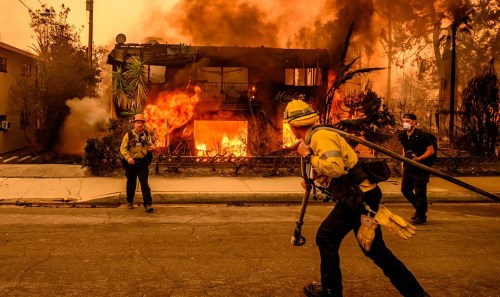Multiple wildfires have been devastating parts of Southern California since Tuesday morning, January 7—many of which are still uncontained. As of today, CNN reports that the fires have led to at least ten deaths and burned nearly 36,000 acres. More than 10,000 buildings have been destroyed, and the destruction has unfortunately left many Los Angeles-area residents without housing.
According to the California Department of Forestry and Fire Protection (CAL FIRE), six active fires make up the wildfire spread so far. The Palisades and Eaton wildfires, which have been the most disastrous, are now eight percent and three percent contained, respectively. More progress has been made on three others: the Lidia fire is 75 percent contained, the Hurst fire is 37 percent contained, and the Kenneth fire is 35 percent contained. The sixth fire, known as the Archer fire, began today and is currently at zero percent containment.
The causes of the fires remain under investigation, but they quickly flourished due to the low humidity and Santa Ana winds in the Los Angeles area. Parts of the region are still under a red flag warning, per the National Weather Service, meaning the wildfire risk is still high.
More than 150,000 people are still under evacuation orders, according to NBC Los Angeles, and many people have started sharing their experiences of displacement on social media.
Officials are warning several communities throughout the LA area to be prepared to evacuate should the fires intensify, and many organizations are already on the ground providing aid to people who lost their homes. Below, you’ll find safety tips people in Los Angeles need to know right now, plus how you can help from near or afar.
How to keep yourself safe
If you are currently impacted by the wildfires or are in the path of the fires, keeping yourself and your loved ones safe is a top priority. Consider the following tips to ensure your safety.
Sign up for emergency alerts
It’s quick and easy to sign up for local emergency alerts, and they can be lifesaving. If you’re in the Los Angeles area, you can find more information at AlertLA.org. Here, you can enter your phone number, email, and address to sign up for safety alerts that might affect your home or the areas around you. As we’ve seen this week, wildfires can change and grow quickly, so these updates are among the best tools we have for making sure people know when they’re in danger. (On that note, make sure you keep your phone charged.) The WatchDuty app is also providing real-time coverage of the wildfires so you can monitor the map, containment levels, and more.
Round up the supplies you might need
Make a list of what you will need should you need to evacuate. Your evacuation bag may include important documents, irreplaceable photos or memories, medications you take, a first aid emergency kit, water, food for your family and pets, a flashlight, your devices and their chargers, N95 masks to protect your lungs during the poor air quality conditions, and anything else you would need if you had to leave your home for an extended period. If you have room in your car or other transportation vehicle, grab any valuable items that can fit.
Make sure your whole family knows the emergency plan
If you have to evacuate, everyone in your household should be on the same page. If you live in an area under an evacuation notice—meaning you could soon receive an evacuation order—now is the time to speak with your family members or roommates about what will happen should you need to evacuate. It’s a good idea to map out at least two evacuation routes, in case your first choice is closed off due to fire hazards.
Don’t ignore instructions from officials
If your home is under an evacuation order, you should leave your home. Whether or not you can see immediate danger at the time an order is given is irrelevant, and officials are constantly monitoring the threat to your home and your community. By leaving when you’re asked to, you can ensure your safety as well as the safety of the firefighters and other officials working on your behalf.
Check out these resources if you’re in the Los Angeles area
Many people and agencies are offering shelter and supplies to those who have been evacuated or displaced. The below links can provide more information on emergency supplies and shelter options should you need them.
- Shelters: The shelters on this list are serving people who have been displaced by the fires. The list includes locations ranging from Los Angeles to Pasadena, and cities in between.
- Food pantries: This food pantry locator can help those in need of food and water. Additionally, some restaurants have opened their doors to survivors of the fire and are feeding first responders and people who have been displaced. ABC7 Eyewitness News compiled a list of restaurants providing food, which you can find here.
- Animal shelters: The Los Angeles Department of Animal Care and Control (DACC) is offering several options for animal shelters, for pets both big and small. World Animal Protection, a non-profit organization, has also created a list of animal shelters in different cities around Los Angeles County.
- Mutual aid: Several other services such as meal distribution, family reunification, mental health services, sanitary products, childcare, clothing distribution, and more are also available on this Google sheet created by Mutual Aid LA Network (MALAN). The document is constantly being updated with contact information and services provided all over the LA area.
How to support wildfire victims right now
If you are looking to help communities in Southern California as these wildfires continue to rage on, consider the following options.
Where to donate money to help people affected by the California wildfires
Several organizations have set up ways to donate monetary funds to victims of the wildfires. These include:
- Los Angeles Fire Department Foundation
- American Red Cross
- GoFundMe Community Page for Wildfire Relief
- California Community Foundation Wildfire Recovery Fund
- Los Angeles Regional Food Bank
Other organizations for specific causes are also relying on community support:
- California Fire Foundation is giving support to firefighters and their families
- Friends in Deed are offering shelters for people experiencing homelessness
- International Medical Corps are delivering emergency relief supplies
- Canine Rescue Club is asking for help in temporarily fostering pets affected by the fire
- World Central Kitchen is preparing hot meals
- Baby2Baby is providing diapers, formula, and food for families
Additionally, individuals on social media have also been sharing their stories and their own donation requests if you’d like to check your own feeds or timelines for folks asking for support.
Other ways to help
You don’t have to donate to help in the recovery efforts. The American Red Cross is taking applications for volunteers who can help, and many organizations are seeking donations of certain items people will need in the coming days. Multiple YMCA locations in Southern California are seeking clothing, toiletries, blankets, non-perishables, diapers, formula, and more, which you can learn more about here.
Check on your LA-area friends
Everyone in Southern California is grieving the loss of communities in the Los Angeles region. Make sure to check on your friends in the area—now and in the coming weeks—to see how you can support them. If you’re able, you can offer emotional support, a place to stay if you live nearby the region, or send them resources for things they may need, such as food, clothing, or pet or childcare services.
The bottom line
If you’re in Los Angeles, make sure you stay up-to-date on the latest threats, and if you’re not, make a list of ways you might be able to help. It can be overwhelming to know where to start, but the important thing is to get involved however you can.
In between doomscrolling, make space for some silver linings. The Los Angeles wildfires come just four months after Hurricane Helene devastated parts of the Southeast, destroying homes, neighborhoods, and communities. Then, and now, people jumped into action to help those who lost everything. Despite the horrific images being shared online, it’s important to remember that the outpouring of support in the wake of both tragedies has been strong, and it’s essential to take care of yourself and each other in these difficult times.
Sign Up for Our Daily Newsletter
Get all the latest in wellness, trends, food, fitness, beauty, and more delivered right to your inbox.
Got it, you've been added to our email list.











